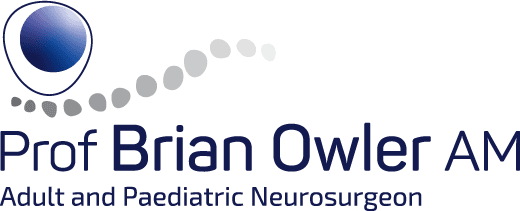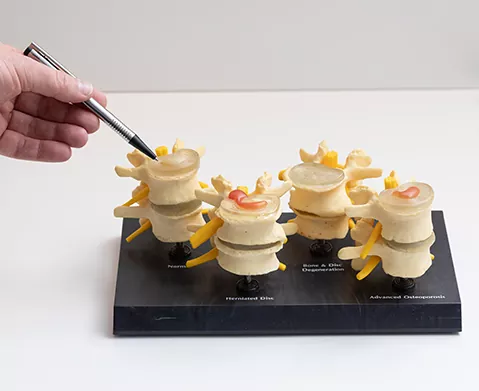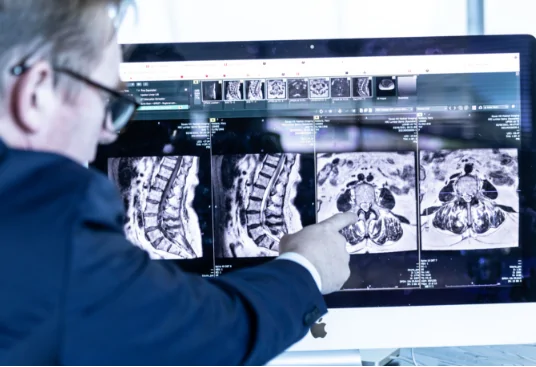

Conservative management includes physiotherapy, chiropractic, massage and acupuncture, etc. Most of these treatments are aimed at symptom control. Although some claim that the disc can be ‘popped’ back into position, this is not possible. Traction may reduce the bulge or protrusion temporarily but it will return when the patient is upright and weight is again placed through the disc. Discs do however shrink and in some cases, disappear over time. This is most likely due to a natural healing process.
In the initial stages, when pain is severe, bed rest and analgesia are advised. Analgesics should be prescribed by the general practitioner. It may include painkillers such as codeine and paracetamol along with anti-inflammatories. When the initial pain begins to improve, physical therapy with a focus on gentle exercise and stretching is appropriate. This will also include core-strengthening exercises. Exercises and activities are normally gradually upgraded as the pain resolves. Most patients (80-90%) will be successfully managed in this manner.

While a microdiscectomy is one of the safest and most common spinal operations performed, all surgery caries risk. There are risks common to all surgeries such as infection, bleeding, deep vein thrombosis (DVT), pulmonary embolism and those associated with a general anaesthetic.
The spinal cord is normally well clear of the site of the surgery. In the lower lumbar spine, the spinal cord has changed into a group of nerve roots called the cauda equina. While patients commonly worry about complications such as paraplegia and incontinence, such problems would be extremely rare. More common is the chance of injuring one nerve root at the site of the surgery and the risk of this is less than 1% and may result in numbness or weakness of the leg which may be permanent.
The most common complication is that of disc recurrence. The rate of recurrence is approximately 10% and may occur early or late. This usually results in recurrence of symptoms and may require a reoperation. The reason for recurrence is that the disc is unhealthy with or without surgery. While the protruding fragment and any other loose disc is removed, the aim is to keep as much of the disc as possible behind. Thus, after the surgery further disc material may occasionally come out of the disc space; usually through the same hole, and compress the nerve.
Occasionally patients will experience persistent back pain after surgery. This occurs in about 10% of patients. It normally does resolve. It probably occurs because of the disc itself. It can sometimes be treated with further surgery but that is rare.
Persistent or recurrent pain in the leg can occur for several reasons. It may be that there is a disc recurrence as mentioned above. However, some patients will experience leg pain because of changes that occur in the nerve itself after it has been compressed severely or for an extended period. This pain, which often has a burning quality, is termed neuropathic pain.
There are numerous other very rare complications that may also occur including those associated with a general anaesthetic such as reactions to medication, visual loss, discitis, i.e., a deep-seated infection of the disc space.
The hospital stay is normally around 1-2 days in total but varies depending on the patient and their underlying condition. During the hospital stay, the patient receives daily physiotherapy. Patients will receive prophylactic subcutaneous heparin injections and are required to wear stockings to prevent DVTs.
After surgery, there is normally some discomfort and analgesia is provided. However, the amount of analgesia required is usually small. Constipation is a common complaint after surgery and is usually due to analgesics. You should inform staff if this becomes an issue.
The main physical restriction relates to lifting. For the first 2 weeks, there should be no lifting but this can be slowly increased after that period to weights <5Kg for another 4 weeks. Patients are then able to lift weights <10Kg until 3 months post-operatively. Generally, no-one should be lifting weights >20Kg even after 3 months but this needs to be balanced against the patients’ occupation and normal activities.
Patients are encouraged to walk and undertake gentle exercise from around 2 weeks after surgery. This is gradually increased after surgery depending on how the patient feels. Exercise should be non-impact for the first 3 months. Therefore, activities such as running should not be undertaken until after that time.
Pain is the most common symptom of radiculopathy and, in most cases, is the first symptom to improve; often immediately after the surgery. Pins and needles may take longer but tend to improve quickly.
Numbness takes the longest period to recover, perhaps even over 12 months and some patients may not experience full recovery of numbness.
Weakness has variable recovery depending on severity and duration before surgery. Some patients will experience recovery immediately while others may have persistent weakness despite the surgery. Normally physiotherapy is required to treat weakness.
Overall, about 90% of patients will experience significant improvement in pre-operative symptoms while a further 10% will not improve as much as is hoped and 1-2% percentage will be worse off in relation pain or some other problem. No guarantees can be given in relation to the surgery.
